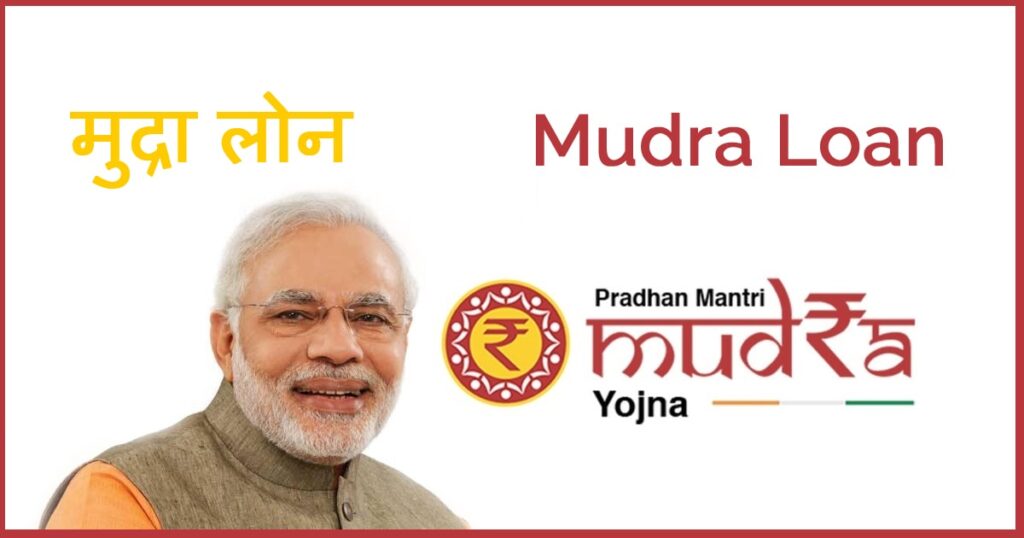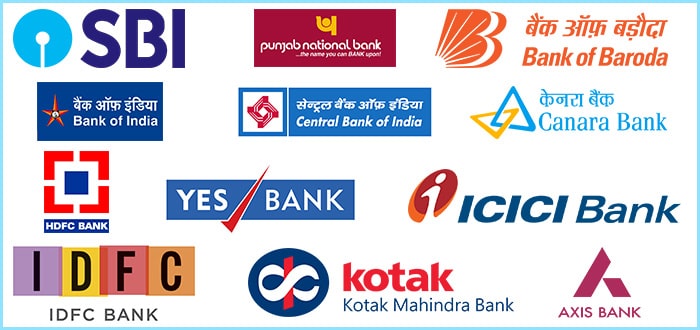MUDRA stands for Micro Units Development and Refinance Agency Limited. It is an NBFC supporting the development of India’s micro enterprise sector. MUDRA offers refinance assistances to Banks, MFIs, and NBFCs for the purpose of lending to the micro units. MUDRA also offers refinance assistances to micro businesses under the Pradhan Mantri MUDRA Yojana (PMMY) scheme.
Pradhan Mantri MUDRA Yojana (PMMY) was launched on April 8, 2015 by the Indian Prime Minister Mr. Narendra Modi with a purpose to provide loans to the non-corporate, non-farm small and micro enterprises. The loans are extended through refinancing scheme through Commercial Banks, RRBs, Small Finance Banks, MFIs and NBFCs. The loans do not require a middleman and the borrower can directly avail the loans up to an amount of Rs. 10 lakhs through the above-mentioned lending agencies. Borrowers can also apply for the loan online at the official site www.udyamimitra.in.

Table of Contents
Vision behind MUDRA Loan
The vision behind MUDRA loan is to integrate financial and support services to serve those who are at the bottom of the pyramid and help them with comprehensive support for fiscal and social development. MUDRA loan visualizes a stronger Indian economy and promotes and guides entrepreneurs through different stages of development.
Purpose of MUDRA Loan
The primary purpose of MUDRA loan is to promote development in an inclusive and sustainable manner through support and promotion of partner institutions. It strives to create an ecosystem of growth for the micro-level enterprise segment.

Mudra loan could be acquired for varied purposes with the end desired outcome to generate income and create employment opportunities. The basic loans are approved in the categories listed below:
- Business loans for shopkeepers, traders, vendors, and other service sectors
- Working capital loan via MUDRA Cards
- Loans for micro units for equipment finance
- Commercial-purpose transport vehicle loans
- Loans for agricultural-allied non-farm income generating activities, such as apiculture, fish farming, and animal husbandry
- Loans for tractors, tillers, and commercial-purpose two wheelers
Listed below is an illustrative list of the activities that can be covered under MUDRA loans:
1) Transport Vehicle
The purchase of transport vehicles is eligible under MUDRA loans. Such transport vehicles should be carriers of transportation merchandizes and passengers. The vehicles under this category comprise of auto rickshaws, small goods transport vehicles, three-wheelers, e-rickshaws, and taxis. Moreover, farm utility vehicles which are used solely for commercial purpose such as tractors, tractor trolleys, power tillers are also eligible for assistance under PMMY. Lastly, two-wheelers used for commercial purpose also qualify for MUDRA loans.
2) Community, Social & Personal Service Activities
MUDRA loans are also given out for community, social, and personal service activities that would benefit the small-scale service providers. The vendors and services covered under it are salons, beauty parlours, gymnasium, boutiques, tailoring shops, dry cleaners, two-wheeler repair shops, DTP and photocopying facilities, medicine shops, and courier services.
3) Food Products Sector
The food product sector also benefits under the MUDRA loans. The PMMY scheme covers activities like papad making, pickle making, jam and jelly making, rural-level preservation of agricultural products, sweet shops, isolated food stalls, day-to-day catering and canteen services, cold chain vehicles, cold storages, ice-making facilities, ice-cream outlets, biscuit outlets, bakeries, and other food-producing outlets.
4) Textile Products Sector / Activity
The textile products sector benefits from assistances under MUDRA loans. The units covered under this sector include apparel design, chikan work, computerized embroidery, cotton ginning, handloom, khadi, knitting, powerloom, zari and zardozi work, traditional embroidery and hand work, traditional dyeing and printing, stitching, and manufacture ofr textile non garment products like bags, furnishing materials, and vehicle accessories.
5) Business loans for Traders and Shopkeepers
MUDRA loans are extended to traders and shopkeepers to help them start, run, or expand their shops, trades, businesses, service enterprises, and non-farm income generating activities. Here every individual borrower benefit from an amount up to 10 lakhs for the individual enterprise activity.
6) Equipment Finance Scheme for Micro Units
Buying and setting up of equipment are a big necessity for a micro unit to increase the productivity and enhance sales. MUDRA loans assist in this activity by giving out loans up to a value of Rs. 10 lakhs to purchase the essential machinery and equipment.
7) Activities allied to agriculture
MUDRA loan is a big help for ‘activities allied to agriculture’ by extending them the necessary financial support. Such activities comprise of fish farming, bee keeping, dairy, poultry, husbandry, grading, sorting, aggregation agro industries, agri-clinics and agribusiness centres, and food & agro-processing. These activities do not include crop loans and land improvement loans but are dependent on services that promote livelihood and generate income.
Achievements of MUDRA Loans
MUDRA loans have been sanctioned to a huge number of beneficiaries. In the financial year 2019-2020, a total of 62237981 PMMY loans were sanctioned, the actual amount sanctioned was Rs. 337465.13, while the total amount allotted was Rs. 329683.63.
Offering /Types of Loans
MUDRA provides a bouquet of offerings targeted across various beneficiary segments. These offerings are
- Technology Enabler
- Refinance for Micro Units to Commercial Banks/ NBFCs/ RRBs/ SFBs/MFIs
- Credit Guarantee for MUDRA Loan
- Development of Promotional Support
MUDRA offers three categories of loan to promote entrepreneurship in India- Shishu, Kishore, and Tarun. These categories signify the stage of growth and the funding requirements of the entrepreneurs along with the reference point for next graduation phase. The focus is more on Shishu phase and least on Tarun phase to promote entrepreneurship in youth.
- Shishu Loan: It is extended to small entrepreneurs to an amount up to Rs. 50,000
- Kishore Loan: This loan is provided in the range of Rs. 50,000 and Rs. 5,00,000.
- Tarun Loan: The loan is extended in the range of Rs. 5,00,000 and Rs. 10,00,000.
MUDRA is designed in a manner to fulfil the needs of diverse economic segments in a range of business activities. MUDRA supports the funding under two types:
- Micro Credit Scheme (MCS)
- Refinance Scheme for Banks/ NBFCs:
Micro Credit Scheme: It is primarily offered through Micro Finance Institutions (MFIs) and sanctions loans up to the amount of Rs. 1 lakh. The loans are awarded to numerous micro enterprises and small business activities. Here the delivery model could be through SHGs, JLGs, or even individuals, however, the loans are meted out by the MFIs to individual businesspersons for some particular income-generating micro enterprise or small business undertakings.
Refinance Scheme for Banks/NBFCs: Different banking sectors in India such as commercial banks, Regional Rural Banks, Small Finance Banks, and NBFCs are entitled to benefit from the refinance assistance of MUDRA for the purpose of financing micro enterprise undertakings. The amount under refinance is up to Rs. 10 lakhs and this sum is available for term loan and working capital loan. The loans can be availed under the three basic categories- Shishu, Kishore, and Tarun. There is a greater stress on promoting women entrepreneurs who benefit from added facilities under PMMY scheme such as reduced interest rates. Currently, the reduction extended under MUDRA amounts to 25bps in the interest rates to MFIs and NBFCs in their loan disbursements to women entrepreneurs.
Eligibility
There are different eligibility criteria for different institutions. They are listed as under:
- Scheduled Commercial Banks
| Level of NPA | Net Profit | CRAR | Net Worth | |
| Public Sector Banks | Cap at 15% | Should show profit for the last two years or have a minimum external rating of long-term instruments of A-(minus) from accredited credit rating agencies | As stipulated by RBI | Above Rs. 250 Crore |
| Private Sector Banks | Cap at 10% | Should show profit for the last two years or have a minimum external rating of long-term instruments of A-(minus) from accredited credit rating agencies | As stipulated by RBI | Above Rs. 250 Crore |
| Foreign Banks | Cap at 10% | Should show profit for the last two years or have a minimum external rating of long-term instruments of A-(minus) from accredited credit rating agencies | As stipulated by RBI | Above Rs. 250 Crore |
| Regional Rural Banks | Cap at 3% | Net profit for last two years | As stipulated by RBI | Above Rs. 50 Crore |
- Small Finance Banks (SFBs)
| 1. | Eligible Institution | Final license granted by Reserve Bank of India to perform in the capacity of Small Finance Bank.The SFB along with its earlier avatar or identity must have earned profit in the past two financial years.In the instance of loss, a need-based relaxation could be given if a minimum BBB+ rating has been maintained for long duration. |
| 2. | Benchmark for Sanction | Parameters Benchmark Norm Net-worth > or = Rs. 100 Crore CRAR or = 15% Gross NPA < or = 5% Net NPA < or = 3% DER # < 10: 1 External Rating Norm External minimum long-term rating of BBB+ |
- Microfinance Institutions (MFIs)
| Sr. No. | Eligibility Parameter | Portfolio (AUM including off balance sheet) | |||||
| Small (< Rs. 100 Crore) | Medium (Rs. 100 Crore <= 500 Crore) | Large (Rs. 500 Crore <) | |||||
| a. | Entity Type | Registered Legal Entity such as NBFC-MFI, Society, and Trust that meets the parameters stipulated by RBI at regular intervals. | |||||
| b. | 1. Profitable Track Record 2. Business Vintage | 1. Profitable track record (from verified audited finances) of last two years. In the instance of valid loss, at least one-year profit record. 2. Should possess a declaratory confirmation from Statutory Auditors to have completed three years as Micro-finance entity. | |||||
| c. | NOF | North-eastern region- Rs. 2 Crore Other parts of India- Rs. 5 Crore | |||||
| No. of Existing Borrowers | Minimum of 10,000 existing borrowers | Minimum of 30,000 existing borrowers | Minimum of 1 lakh existing borrowers. | ||||
| Capacity Assessment Rating | Should have received minimum Capacity Assessment Grading of mfr5 of CRISIL or equivalent. | Should have received minimum Capacity Assessment Grading of mfr4 of CRISIL or equivalent. | |||||
| MFI Density | MFI of 50% or more of portfolio in Bihar, Karnataka, Tamil Nadu, Odisha, and West Bengal and minimum MFI grading equal to CRISIL is Mfr4. | ||||||
| Grading for exposure 25 Crore < | MFI must undergo three grading with eligible investment grades according to the existing MUDRA guidelines with the latest grade >= mfr3 | ||||||
| Bank Loan Rating (BLR) | The BLR must have minimum acceptable investment rating. The BLR rating is applicable for exposures above Rs. 5 Crores only. | ||||||
| System and Processes | Must possess suitable systems, procedures and processes like cash management, MIS, internal audit and accounting, and risk management. | ||||||
| CRAR | NBFC-MFIs- As per existing RBI rubrics. Currently- 15%, Other MFIs- 15% | ||||||
| Compliance to RBI rubrics | To comply with existing RBI rubrics. | ||||||
| Recovery Performance | Recovery performance or collection efficiency on a monthly basis must be more than or equal to 95%. | ||||||
| Portfolio at Risk (PAR) > 90 days | PAR > 90 days below 3% | ||||||
| Member of Credit Bureaus | Should be member of existing credit bureau as mandated by RBI. | ||||||
| Minimum Loan Requirement | Rs. 0.5 Crore | ||||||
| Uploading of Data on MUDRA’s Online Portal | Performance data and NPA status must be uploaded at regular intervals on MUDRA’s online portal. | ||||||
| Debt Equity Ratio | 7:1 for NBFC MFIs 10:1 for non-NBFC MFIs (Excluding BC Portfolio) | ||||||
- Non-banking Finance Companies (NBFCs)
| Parameter | for Assets size >= Rs. 500 Crore | for Assets size < Rs. 500 Crore | |
| Type of NBFC | The different types of NBFCs are: Asset Finance Companies (AFC)Loan Companies (LC) also known as Investment and Credit Companies. Two-tier NBFCs providing loans and resources to support the NFIs | ||
| Track Record | The NBFC should be in business for a minimum of five years and earning profit for the last three financial years. For financing of second-hand vehicles, the NBFC must be in business for three years and earning profit throughout the duration. | ||
| Net Owned Funds and Asset Size | Minimum net-owned fund should be Rs. 20 Crore and minimum size of asset must be Rs. 500 Crore. | Minimum net-owned fund should be Rs. 15 Crore and minimum size of asset must be Rs. 250 Crore. A business of minimum Rs. 20 Crore should have undertaken in the last fiscal year. The sanctioning committee could provide suitable relaxation based on minimum lending business criteria. | |
| External Rating Norms | External long-duration rating range of BBB+ and above. NBFCs having assets more than 500 Crore could enjoy a need-based relaxation by sanctioning committee for up to BBB-. | External long-duration rating range of BB- and above. | |
| CRAR | Minimum 15% or according to RBI stipulation | ||
| DER | <= 7:1 (excluding off-balance sheet portfolio) | ||
| NPA Norm | NBFC Rating Gross NPA Net NPA AAA <10% <5% AA <8% =<4% A <6% =<3% Below A =<5% <3% No Relaxation |
Popular Banks Offering MUDRA Loan
There are 203 partner institutions that offer MUDRA loans. They consist of co-operative banks, MFIs (Micro Finance Institutions), NBFC (Non-Banking Financial Company), NBFC- MFI, private sector banks, public sector banks, RRB (Regional Rural Bank), and SFB (Small Financial Bank). Some of the popular private sector banks include Axis Bank Ltd., HDFC Bank Ltd., ICICI Bank Ltd., IDFC Bank Ltd., Karnataka Bank Ltd., Kotak Mahindra Bank Ltd., South India Bank, and Yes Bank Ltd.
The names of popular public sector bank are Allahabad Bank, Andhra Bank, Bank of Baroda, Bank of India, Bank of Maharashtra, Canara Bank, Central Bank of India, Corporation Bank, Dena Bank, IDBI Bank Ltd., Indian Bank, Indian Overseas Bank, Oriental Bank of Commerce, Punjab & Sind Bank, Punjab National Bank, State Bank of India, Syndicate Bank, and UCO Bank.

Contact Details
For any query to MUDRA loans, you can contact the concerned authorities through a number of portals such as email, postal mail, and telephonic connect. To know the various ways by which you can contact MUDRA officers please read under.
- Email address: You can email your query to MUDRA officials at the official email id [email protected].
- Registered office: You can also walk up to MUDRA office or post your query at the registered office address Swavalamban Bhavan, C-11, G-Block, Bandra Kurla Complex, Bandra East, Mumbai – 400051
- PMMY tollfree numbers: There are different tollfree numbers for PMMY schemes for each of the Indian State and Union Territory. There are also two national tollfree numbers 1800 180 1111 and 1800 11 0001. You can dial on any one of them to get answers for your queries.
- Bank Nodal Officers: You can also contact the nodal officers of different banks to cite your grievances. These nodal officers are in the position of GM (except for Indian Bank whose nodal officer is in the rank of DGM). You can contact the officers on their official landline numbers or their official email ids. The banks who have their nodal officers listed with MUDRA are Allahabad Bank, Andhra Bank, Bank of Baroda, Bank of India, Bank of Maharashtra, Canara Bank, Central Bank of India, Corporation Bank, Indian Bank, Indian Overseas Bank, Punjab & Sind Bank, Punjab National Bank, State Bank of India, Syndicate Bank, UCO Bank, Union Bank of India, and United Bank of India.
- MUDRA Officers in Mumbai: You can also directly contact the various MUDRA officers in Mumbai through their official email ids or their official landline numbers. These officers range in the ranking from Assistant Manager to MD & CEO.
- PMMY Mission Office: Lastly, you can contact at the PMMY Mission Office at the official email id [email protected] or at the official landline number 011-47072748.
FAQs
MUDRA stands for Micro Units Development & Refinance Agency Ltd. It is an Indian Government financial institution whose main aim is to develop and refinance the micro units enterprises. Its purpose is to offer financial support to the non-corporate small business sector via diverse Last Mile Financial Institutions such as banks, NBFCs and MFIs.
The government of India realizes that the Non–Corporate Small Business Sector (NCSBS) suffers from the problem of financial support. This puts a hindrance on the growth of entrepreneurship and thereby the government loses on important source of revenues and a chance for job creation. Studies have found that more than 90% of NCSBS segment suffer from a shortage of finances as there are limited sources of formal finance. Therefore, MUDRA Bank has been introduced by the Government of India through a statutory enactment to cater to the needs of the NCSBS segment or the informal sector and bring them in the mainstream trading sector.
MUDRA is responsible for refinancing all Last Mile Financiers like Non-Banking Finance Companies, MFIs, Societies, Trusts, Section 8 Companies, SFBs and RRBs that engages in lending practices to micro and small business entities connected with manufacturing, trading, services, and agri-allied activities. MUDRA forms a partnership with state and regional level financial intermediaries to extend financial support to Last Mile Financier of small and micro business enterprises.
MUDRA offers three levels of financing under the Pradhan Mantri MUDRA Yojana (PMMY), named as ‘Shishu’, ‘Kishor’ and ‘Tarun’. These three levels of loans portray the stage of growth and development along with the funding requirements of the entrepreneur and act as a reference phase for the next phase of growth. The loaning amount in the different levels are as under:-
a. Shishu: provides loans up to Rs. 50 thousand
b. Kishor: provides loans above Rs. 50 thousand and till the amount of Rs. 5 lakhs
c. Tarun: provides loans more than Rs. 5 lakhs and till the amount of Rs. 10 lakhs
MUDRA does not give direct loans to the beneficiaries but uses the route of refinancing to MFIs, NBFCs, and banks wherein they extend the required loan amount to the beneficiary. MUDRA has associated with a huge network of ‘Last Mile Financiers’ that comprise of companies, trusts, societies, associations, and other networks that can fulfill the informal fiscal needs of the entrepreneurs.
MUDRA caters to a large number of target clients. These consist of Non–Corporate Small Business Segment (NCSB) consisting of millions of proprietorship and partnership firms functioning as small manufacturing units, service sector units, shopkeepers, fruits and vegetable vendors, truck operators, food-service units, repair shops, machine operators, small industries, artisans, food processors and others. They operate in both rural and urban areas.
Yes. The MUDRA website had a one-page Shishu category application format and three-page Kishore and Tarun categories application format designed and posted in MUDRA website. The applicant needs to apply for MUDRA loan through these standard format of application.
I’m Shiv Kumar, a graduate with a passion for finance, marketing, and technology. My journey into finance started with a desire to understand money management and investing.
Our main goal is to empower individuals through financial education. We believe that everyone should have the opportunity to build a strong financial foundation. Whether you’re a seasoned investor or just getting started, we provide articles, guides, and resources to help you navigate the financial landscape.
I invite you to join our community of financially savvy individuals. Feel free to ask questions, engage with our content, and explore the topics that matter to you. Together, let’s take control of our financial futures.




